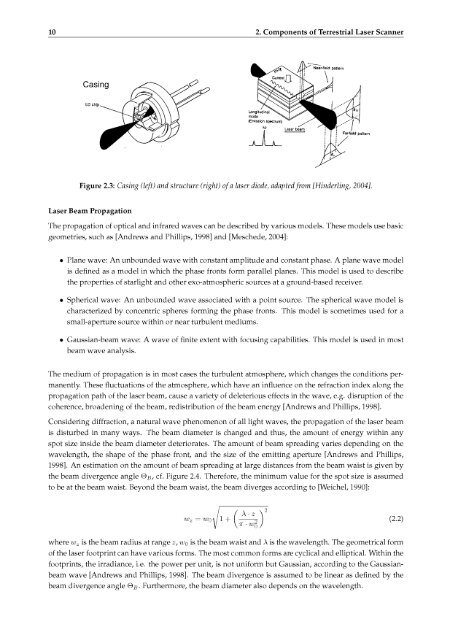Calibration of a Terrestrial Laser Scanner - Institute of Geodesy and ...
Calibration of a Terrestrial Laser Scanner - Institute of Geodesy and ...
Calibration of a Terrestrial Laser Scanner - Institute of Geodesy and ...
You also want an ePaper? Increase the reach of your titles
YUMPU automatically turns print PDFs into web optimized ePapers that Google loves.
10 2. Components <strong>of</strong> <strong>Terrestrial</strong> <strong>Laser</strong> <strong>Scanner</strong>Figure 2.3: Casing (left) <strong>and</strong> structure (right) <strong>of</strong> a laser diode, adaptedfrom [Hinderung, 2004]<strong>Laser</strong> Beam PropagationThe propagation <strong>of</strong> optical <strong>and</strong> infrared waves can be described by various models These models use basicgeometries, such as [Andrews <strong>and</strong> Phillips, 1998] <strong>and</strong> [Meschede, 2004]• Plane wave An unbounded wave with constant amplitude <strong>and</strong> constant phase A planewave modelis defined as a model in which the phase fronts form parallel planesThis model is used to describethe properties <strong>of</strong> starlight <strong>and</strong> other exo-atmospheric sources at a ground-based receiver• Spherical wave An unbounded wave associated with apoint source The sphericalwave model ischaracterized by concentric spheres forming the phasefronts This model is sometimes used for asmall-aperturesource withm or near turbulent mediums• Gaussian-beam wave A wave <strong>of</strong> finite extent with focusing capabilitiesThis model is used in mostbeam wave analysisThe medium <strong>of</strong> propagation is in most cases the turbulent atmosphere, which changes the conditions per¬manently These fluctuations <strong>of</strong> the atmosphere, which have an influence on the refraction index along thepropagation path <strong>of</strong> the laser beam, cause a variety <strong>of</strong> deleterious effects in the wave, eg disruptioncoherence, broadening <strong>of</strong> the beam, redistribution <strong>of</strong> the beam energy [Andrews <strong>and</strong> Phillips, 1998]Considering diffraction, a natural wave phenomenon <strong>of</strong> all light waves, the propagation<strong>of</strong> the<strong>of</strong> the laser beamis disturbed inmany ways The beam diameter is changed <strong>and</strong> thus, the amount <strong>of</strong> energy within anyspotsize inside the beam diameter deteriorates Theamount <strong>of</strong> beam spreading varies dependingon thewavelength, the shape <strong>of</strong> the phase front, <strong>and</strong> the size <strong>of</strong> the emitting aperture [Andrews <strong>and</strong> Phillips,1998] An estimation on the amount <strong>of</strong> beam spreading at large distances from the beam waist is given bythe beam divergence angle ©_b, cf Figure 2 4 Therefore, the minimum value for the spotsize is assumedto be at the beam waist Beyond the beam waist, the beam diverges according to [Weichel, 1990]WZ=W0\ 1+ ( 2(22)where wz is the beam radius at range z, w0 is the beam waist <strong>and</strong> A is the wavelength The geometrical form<strong>of</strong> the laser footprint can have various forms The most common forms are cyclical <strong>and</strong> ellipticalWithin thefootprints, the irradiance, l e the power per unit, is not uniform but Gaussian, accordingto the Gaussianbeamwave [Andrews <strong>and</strong> Phillips, 1998] The beam divergence is assumed to be linear as defined by thebeam divergence angle Ob Furthermore, the beam diameter also depends on the wavelength












